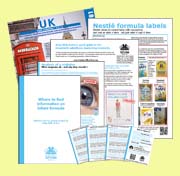IBFAN calls for review of nutrition programmes for malnourished children
IBFAN calls for a review of UN and other programmes using commercial Ready-to-use Therapeutic Foods and supplements following two new Cochrane reviews.
27th June 2013
Two new systematic reviews [1,2] by the Cochrane Collaboration, recognized as the international benchmark for evaluating the effectiveness of health interventions, have found that flour porridge prepared from enriched blended food seems to be just as effective as commercial ready-to-use foods and lipid-based supplements in the home treatment of severe and moderate malnutrition. IBFAN calls on UN bodies such as UNICEF and others to take account of these findings and to review recommendations that place undue emphasis on product-based fortified foods and supplements in programmes that address child malnutrition and survival.
In the analysis of Ready to Use Therapeutic Foods (RUTFs) for the home treatment of children with Severe Acute Malnutrition (SAM), the Cochrane authors conclude "Current evidence is limited and, therefore, we cannot conclude that there is a difference between RUTF and flour porridge as home treatment for severely malnourished children, or between RUTF given in different daily amounts or with different ingredients. Either RUTF or standard diet such as flour porridge can be used to treat severely malnourished children at home. Decisions should be based on availability, cost and practicality. In order to determine the effects of RUTF, more high-quality studies are needed".
The second Cochrane review reveals that giving Lipid-based nutrient supplements (LNS) does not reduce progression from Moderate Acute Malnutrition (MAM) to SAM and has no impact on child mortality. Whatever benefit emerged from the studies on MAM was in the form of weight gain and higher rates of recovery; however, a significant proportion of recovered infants and children relapse into MAM within six months.
Overall, the two Cochrane reviews find no significant added value for MAM and SAM with the use of RUTFs and LNS. The MAM review notes that no research is available that compares commercial with home-made foods and continued breastfeeding - the adequacy of which would be the only sustainable approach to reducing the burden of child malnutrition.
At the same time the Lancet Series on Maternal and Child Nutrition,[3] published in early June and to be launched in India at the end of June, advocates that priority be given to therapeutic feeding for reducing child mortality associated with malnutrition, and that this be followed with interventions largely based on micronutrient-based foods and supplements. These conclusions are drawn despite the fact that the authors of the Lancet paper admit that “available evidence shows some positive effects ... yet the differences were for the most part small,” a finding consistent with the Cochrane review. Indeed, the Lancet did not analyse the treatment of MAM separately but applied to MAM the effect of interventions for SAM. The Lancet also compared the impact of LNS given to one group with standard care that did not include food.
IBFAN is hopeful that these two independent systematic reviews will help settle the long-standing debate about the best way to feed severely and moderately malnourished children, as RUTFs are seen as a useful resource in the existing global guidelines of WHO and other agencies. However, many of the stand-alone studies used to arrive at these guidelines were either funded by or carried out by those who have a financial interest in the outcome, IBFAN believes that this has led to some of the programmes being biased in favour of the delivery of and creation of markets for fortified products. IBFAN calls on UN bodies to take account of the Cochrane reviews and design a total package of care that will protect the rights of the world’s most vulnerable citizens, and to base this on evidence that is as far as possible clear of conflicts of interest.
Meanwhile breastfeeding and adequate complementary feeding, continues to receive scant funding and attention despite the large body of research that demonstrates it is (by far) the most effective and sustainable intervention to positively impact child health and survival. IBFAN believes this is because breastfeeding protection is not just a matter of promotion - but involves a fundamental rethink of approach, including legislation that provides maternity protection for working women [4] and stops misleading marketing practices for formulas and foods for infants and young children. This would conflict with the food industry's top strategic priority which is to expand markets for ultra-processed foods, using claims about micronutrients to undermine confidence in family foods and traditional eating patterns.
1. Schoonees A, Lombard M, Musekiwa A, Nel E, Volmink J. Ready-to-use therapeutic food for home-based treatment of severe acute malnutrition in children from six months to five years of age. Cochrane Database of Systematic Reviews 2013, Issue 6. Art. No.: CD009000. DOI: 10.1002/14651858.CD009000.pub2 http://onlinelibrary.wiley.com/doi/10.1002/14651858.CD009000.pub2/abstract
2. Lazzerini M, Rubert L, Pani P. Specially formulated foods for treating children with moderate acute malnutrition in low- and middle-income countries. Cochrane Database of Systematic Reviews 2013, Issue 6. Art. No.: CD009584. DOI:10.1002/14651858.CD009584.pub2 http://onlinelibrary.wiley.com/doi/10.1002/14651858.CD009584.pub2/abstract
3. Bhutta ZA et al. Evidence-based interventions for improvement of maternal and child nutrition: what can be done and at what cost? Lancet Published online June 6, 2013
http://www.thelancet.com/series/maternal-and-child-nutrition
4. WHO Bulletin. Breastfeeding policy - a globally comparative analysis: "A greater percentage of women practise exclusive breastfeeding in countries where laws guarantee breastfeeding breaks at work. If these findings are confirmed in longitudinal studies, health outcomes could be improved by passing legislation on breastfeeding breaks in countries that do not yet ensure the right to breastfeed."http://www.who.int/bulletin/volumes/91/6/12-109363.pdf
CLICK HERE for statement by members of the Indian Academy of Pediatrics on the World Public Health Nutrition Association website.
Policy Implications of Lancet Series on Nutrition, 2013: Guard against Commercial Exploitation of Malnutrition
CLICK HERE for Times of India article entitled: Ignore Lancet Series, Experts tell ....
- Login to post comments






